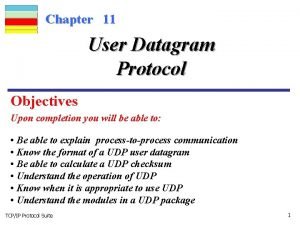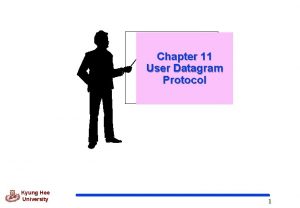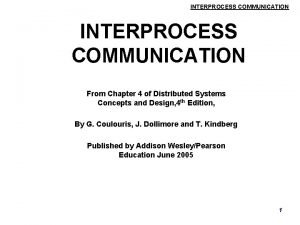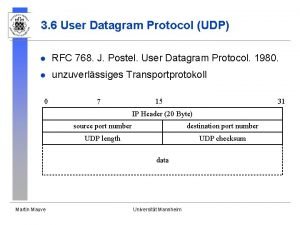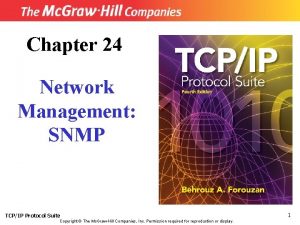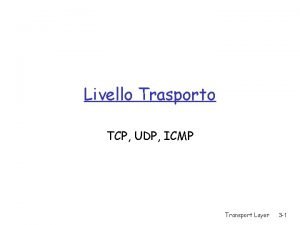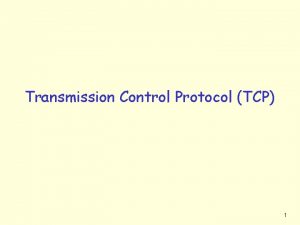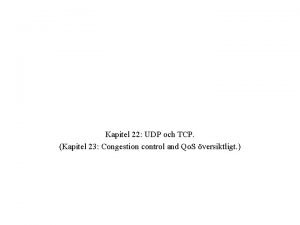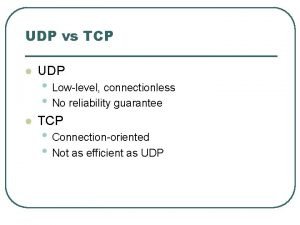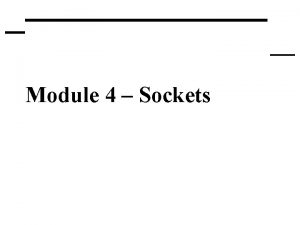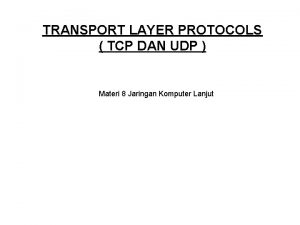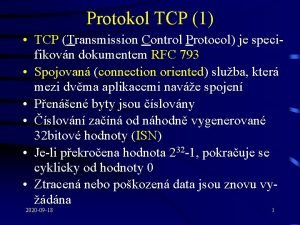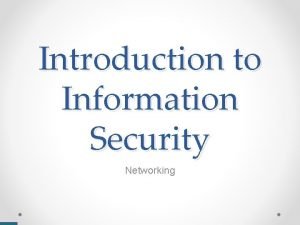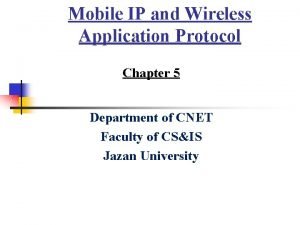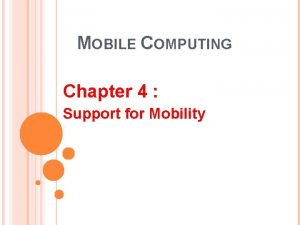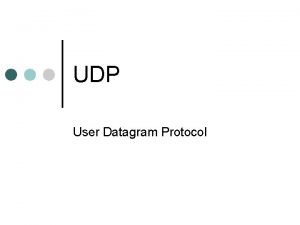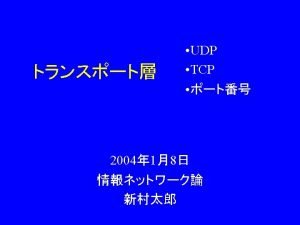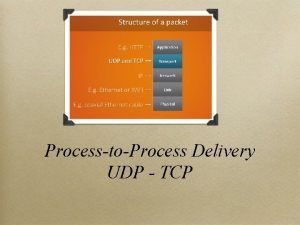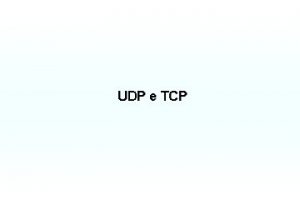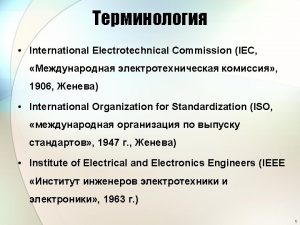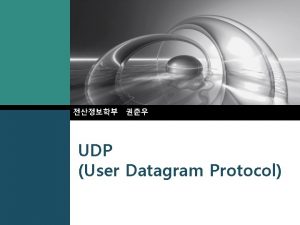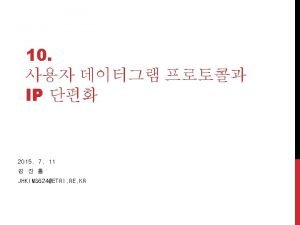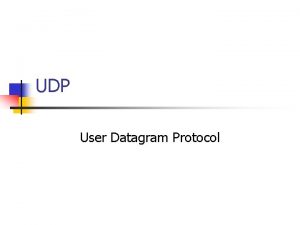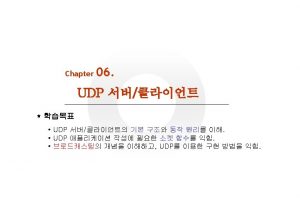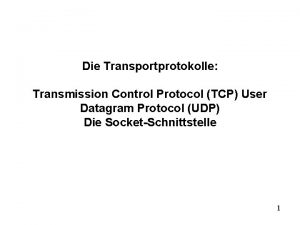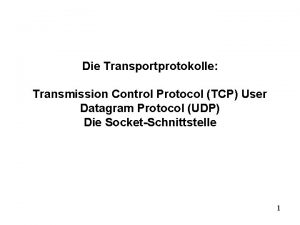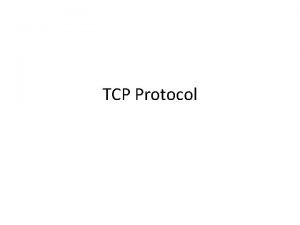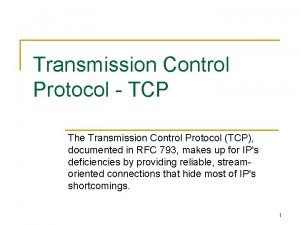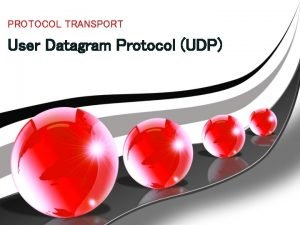UDP TCP User Datagram Protocol Transmission Control Protocol

















- Slides: 17

UDP & TCP User Datagram Protocol & Transmission Control Protocol BS IT 4 th Semester By: Muhammad Hanif

Quote of the day…… Many of life's failures are people who did not realize how close they were to success when they gave up. ~Thomas Edison Have a blessed day!

Transport Protocols Provide logical communication between application processes running on different hosts Run on end hosts ◦ Sender: breaks application messages into segments, and passes to network layer ◦ Receiver: reassembles segments into messages, passes to application layer Multiple transport protocol available to applications ◦ Internet: TCP and UDP

UDP User Datagram Protocol BS IT 4 th Semester By: Muhammad Hanif

Position of UDP in the TCP/IP protocol suite

User Datagram Protocol UDP is an end-to-end or transport protocol that allows an application program to serve as the end-point of communication

UDP Characteristics End-to-end Connectionless Message-oriented ◦ Each UDP message must fit within one IP datagram ◦ UDP message can be lost, duplicated, or corrupted ◦ Suitable for applications that can tolerate delivery errors ◦ One-to-one, one-to-many E. g. Call Internet Telephony, Conference

UDP Format

UDP Format Detail Source Port/Destination Port: A port Virtual circuit between two communicating processes on two different computers or devices The source port is the port on the sending device. The destination port is a TCP port on a receiving device that corresponds with the source port on the sending device Length: contains information about the length of the frame Checksum: This field is used to detect errors over the entire user datagram (header plus data). ◦ Placed in the frame by the sending station. ◦ The recipient also calculates the checksum and compares its calculation with the value in the checksum field.

Encapsulation and Decapsulation

TCP Transmission Control Protocol BS IT 4 th Semester By: Muhammad Hanif

Quote of the day…… Be noble minded! Our own heart, and not other men's opinions of us, forms our true honor. - Johann Friedrich was a German anatomist.

Position of TCP in the TCP/IP protocol suite

TCP Features Reliable, in-order delivery (TCP) ◦ Connection Oriented ◦ Discarding of corrupted packets ◦ Retransmission of lost packets ◦ Flow control

Establishing a TCP Connection Three-way handshake to establish connection ◦ Host A sends a SYN (open) to the host B ◦ Host B returns a SYN acknowledgment (SYN ACK) ◦ Host A sends an ACK to

TCP segment format

Control Fields
 Tcp (transmission control protocol) to protokół
Tcp (transmission control protocol) to protokół User datagram protocol diagram
User datagram protocol diagram In the field of udp, each used datagarm can travel on a
In the field of udp, each used datagarm can travel on a Interprocess communication in distributed systems
Interprocess communication in distributed systems Rfc udp
Rfc udp Snmp port number
Snmp port number Socket programming tcp udp
Socket programming tcp udp Udp icmp
Udp icmp Tcp udp
Tcp udp Udp 23
Udp 23 Tcp vs udp
Tcp vs udp 161 port snmp
161 port snmp Socket.io udp
Socket.io udp Tcp dan udp
Tcp dan udp 4-way handshake
4-way handshake Transmission control protocol
Transmission control protocol Wsp in mobile computing
Wsp in mobile computing Which protocol support mobility portability of equipment
Which protocol support mobility portability of equipment

